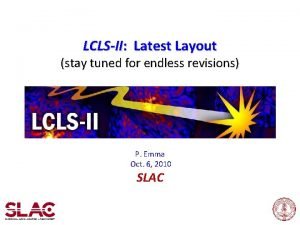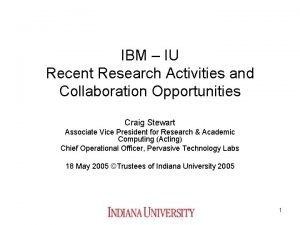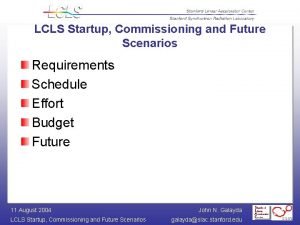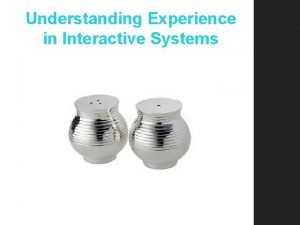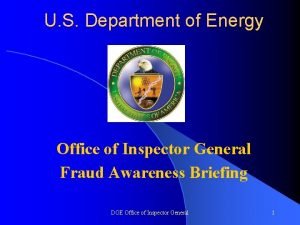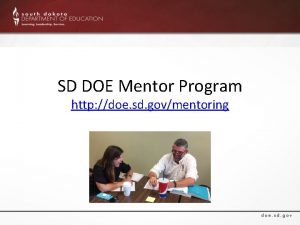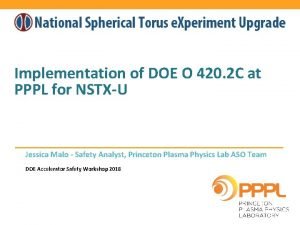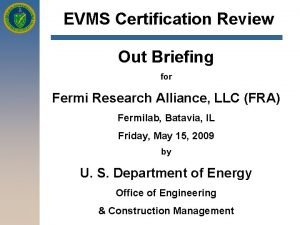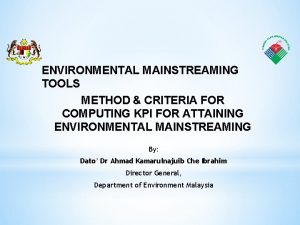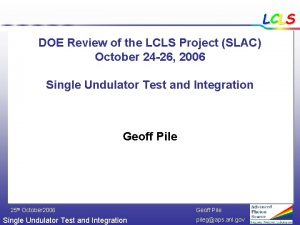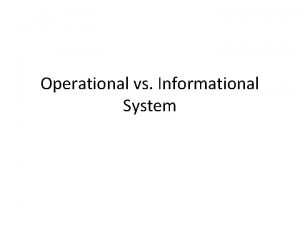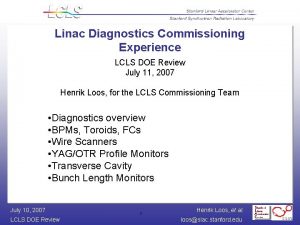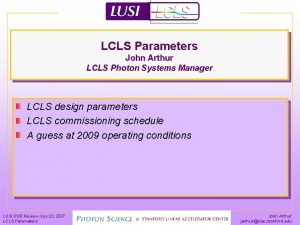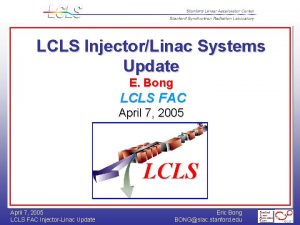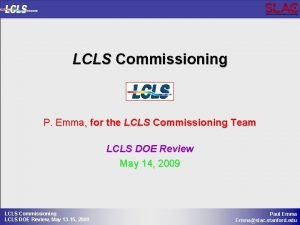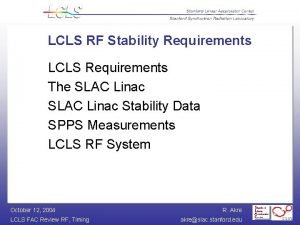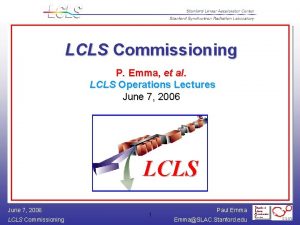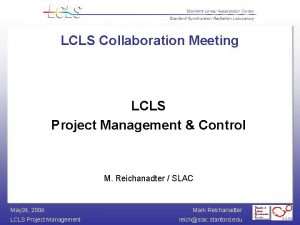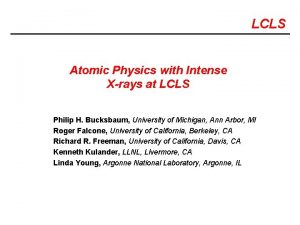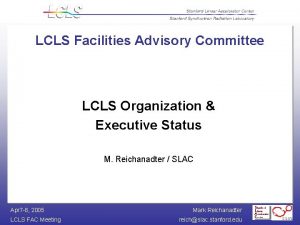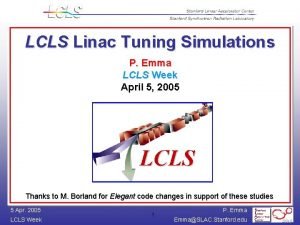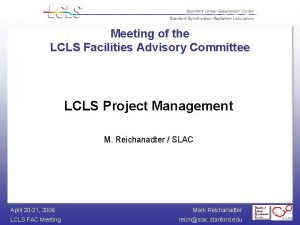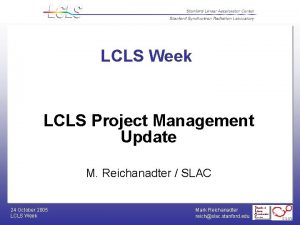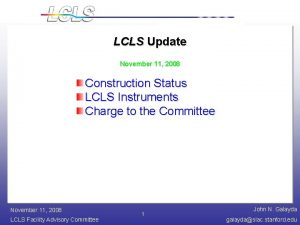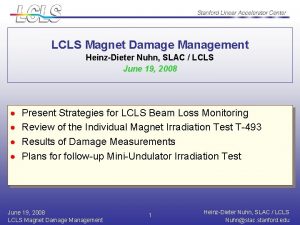Operational Experience with LCLS RF systems LCLS DOE




















- Slides: 20

Operational Experience with LCLS RF systems LCLS DOE Review July 11, 2007 Operational Experience with the LCLS RF Systems Josef Frisch frisch@slac. stanford. edu

LCLS RF systems RF Gun 23 MW 5. 75 MV, ~115 MV/M Laser 30° from crest Standing Wave structure OTR screens (7) YAG screens (7) Wire scanners (7) Dipole magnets (8) Beam stoppers (2) S-band RF acc. sections (5) L 0 A 35 MW, 57 MV, ~20 MV/m 2° nominal (usually on crest) L 0 B 60 MW, 72 MV, ~24 MV/m 10° nominal (usually on crest) Transverse Cavity 2 MW, 1. 4 MV ~4 MV/m 180° transverse : diagnostic L 1 S 147 MV, 20 MV/m 25° nominal 250 Me. V 50% 2 -km point in 3 -km SLAC linac 135 Me. V LCLS DOE Review July 11, 2007 Operational Experience with the LCLS RF Systems 25% L 1 S BC 1 L 1 X X-band ~20 MW, 20 MV, 33 MV/M 160° nominal Josef Frisch frisch@slac. stanford. edu OTR

General RF System Design LCLS DOE Review July 11, 2007 Operational Experience with the LCLS RF Systems Josef Frisch frisch@slac. stanford. edu

RF Gun LCLS DOE Review July 11, 2007 Operational Experience with the LCLS RF Systems Josef Frisch frisch@slac. stanford. edu

RF Gun System Specifics Standing wave structure – field probes to measure RF Contains vacuum sensitive cathode – want to avoid arcs: Hardware RF power interlock. Hi Q system, needs precise temperature control to stay on resonance. Gun operates at high peak field – 115 MV/M. LCLS DOE Review July 11, 2007 Operational Experience with the LCLS RF Systems Josef Frisch frisch@slac. stanford. edu

Gun RF Performance Amplitude Jitter 0. 04% Spec 0. 1% Phase Jitter. 053° Spec 0. 1° (but same read back as feedback) Good Reliability LCLS DOE Review July 11, 2007 Operational Experience with the LCLS RF Systems Josef Frisch frisch@slac. stanford. edu

RF Gun Issues Minimal problems Field probes overheat at high rate, limited to 30 Hz. Re-designed probes to be tested on Gun 2. Software RF feedback can cause problems with interaction with modulator hardware trips. Software tries to maximize power during hardware RF power ramp. LCLS DOE Review July 11, 2007 Operational Experience with the LCLS RF Systems Josef Frisch frisch@slac. stanford. edu

L 0 A RF System Standard S-band RF system Noise problems (modulator Thyratron? ) 0. 2% amplitude Spec 0. 14% 0. 16° Spec 0. 14° System operates with good reliability LCLS DOE Review July 11, 2007 Operational Experience with the LCLS RF Systems Josef Frisch frisch@slac. stanford. edu

L 0 B RF System Standard S-band RF system Good Jitter. 024% amplitude Spec 0. 14% . 043° Phase Spec 0. 14° LCLS DOE Review July 11, 2007 Operational Experience with the LCLS RF Systems Josef Frisch frisch@slac. stanford. edu

L 0 B RF System Overall Excellent jitter (amplitude and phase) performance. Shows how well the S-band Modulator / Klystron can work! Had some processing problems early in the run (L 0 B is our highest gradient S-band structure), but seems OK now. L 0 B Amplitude normally run in feedback for energy stability. RF long term stability < 1% p-p. LCLS DOE Review July 11, 2007 Operational Experience with the LCLS RF Systems Josef Frisch frisch@slac. stanford. edu

Transverse Cavity RF system Standard S-band RF system Operates 90° off crest. Jitter OK, but fliers. 017% amplitude 0. 15° phase Regularly used as a diagnostic LCLS DOE Review July 11, 2007 Operational Experience with the LCLS RF Systems Josef Frisch frisch@slac. stanford. edu

L 1 -S RF System LCLS DOE Review July 11, 2007 Operational Experience with the LCLS RF Systems Josef Frisch frisch@slac. stanford. edu

L 1 S System Specifics Uses SLED cavity to drive 3 structures Operates 25° off crest to provide acceleration and energy chirp for compression 147 MV, 135 Me. V energy gain Phase noise important, off crest operation converts phase noise to bunch length and arrival time error. LCLS DOE Review July 11, 2007 Operational Experience with the LCLS RF Systems Josef Frisch frisch@slac. stanford. edu

L 1 S System Operation Amplitude noise: 0. 043% Spec is 0. 14% Phase noise 0. 10° Spec is 0. 14° Long term stability from beam feedback (BC 1 energy) LCLS DOE Review July 11, 2007 Operational Experience with the LCLS RF Systems Josef Frisch frisch@slac. stanford. edu

L 1 X RF System Uses 60 cm X-band structure Originally developed as part of Next Linear Collider Project. Operates at ~33 MV/M NLC gradient ~70 MV/M XL-4 Klystron Operating at 20 MW Design 50 MW X-band operates 160° off crest (net deceleration) to compensate for curvature of energy vs. time from S -band. LCLS DOE Review July 11, 2007 Operational Experience with the LCLS RF Systems Josef Frisch frisch@slac. stanford. edu

L 1 X RF System Amplitude noise 0. 62% Spec is 0. 25% Phase noise 1. 2° Spec is 0. 5° System reliability has been good LCLS DOE Review July 11, 2007 Operational Experience with the LCLS RF Systems Josef Frisch frisch@slac. stanford. edu

L 1 X Transverse Kicks L 1 X produces an unexpectedly strong transverse kick on the beam. Kick is ~50 degrees out of phase with energy gain. Adjusted timing of RF to eliminate power in couplers during beam passage – did not reduce kick. Not yet understood Energy vs. phase LCLS DOE Review July 11, 2007 Operational Experience with the LCLS RF Systems Emittance vs position Transverse kick Vs. phase Josef Frisch frisch@slac. stanford. edu

Noise and Stability Issues Noise measurements shown were performed with the same sensors that are used in feedback. Not really a fair measurement. Beam based energy measurements also used in feedback Just beginning serious measurements of noise and stability: Initial indications are that overall phase noise is < 1°, but doesn’t yet meet the 0. 1° requirement. Low noise on individual stations indicates that the high power components are capable of meeting the spec. LCLS DOE Review July 11, 2007 Operational Experience with the LCLS RF Systems Josef Frisch frisch@slac. stanford. edu

Near Term Plans Study noise / stability Multiple measurements available: Beam phase cavities, beam energy, bunch length monitors etc. Lack of a single “gold standard” for measuring phase complicates things Study X-band deflection, wakefields, emittance growth. May remove the cavity during the down-time (Sept 07) for RF measurements. LCLS DOE Review July 11, 2007 Operational Experience with the LCLS RF Systems Josef Frisch frisch@slac. stanford. edu

Overall RF Status RF operates with good reliability. All systems running at design gradient. Gun currently at 5. 75 MV, not 6, but believe we can turn up at any time. Phase noise needs some work, but high power equipment seems OK Need to investigate transverse effects in L 1 X. LCLS DOE Review July 11, 2007 Operational Experience with the LCLS RF Systems Josef Frisch frisch@slac. stanford. edu
 Lcls
Lcls Lcls
Lcls Lcls schedule
Lcls schedule Imprinting psychology
Imprinting psychology Early experience vs later experience debate
Early experience vs later experience debate Example of indirect experience
Example of indirect experience Understanding experience in interactive systems
Understanding experience in interactive systems Doe oig
Doe oig Nyc doe efq
Nyc doe efq Sd doe
Sd doe Serp.doe.louisiana
Serp.doe.louisiana Insesis
Insesis Restoration of health nyc doe
Restoration of health nyc doe Homophone hunt
Homophone hunt Jane and john smith
Jane and john smith Doe order 420
Doe order 420 John doe drivers license
John doe drivers license Doe evms
Doe evms Environmental mainstreaming tools
Environmental mainstreaming tools Melissa klembara doe
Melissa klembara doe Doe sustainability dashboard
Doe sustainability dashboard
